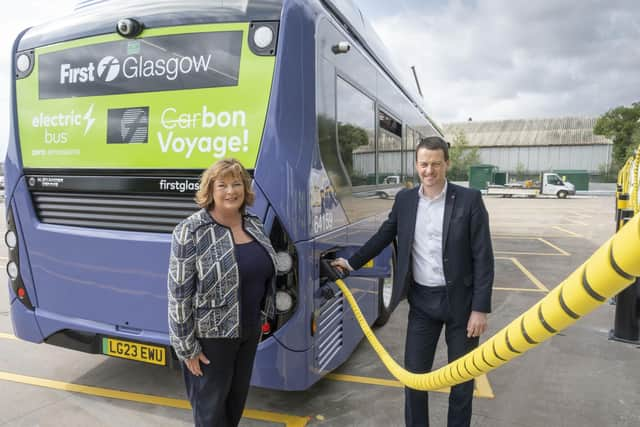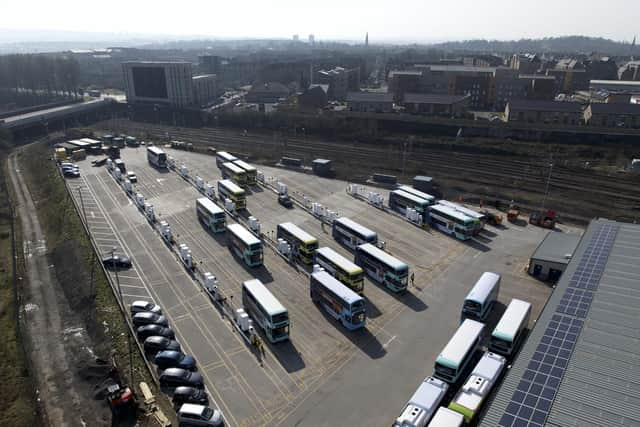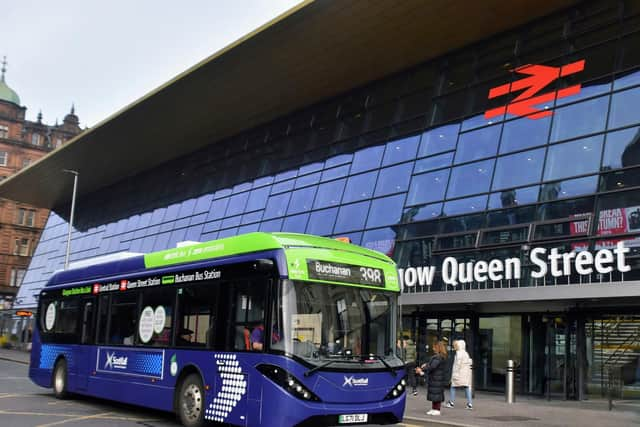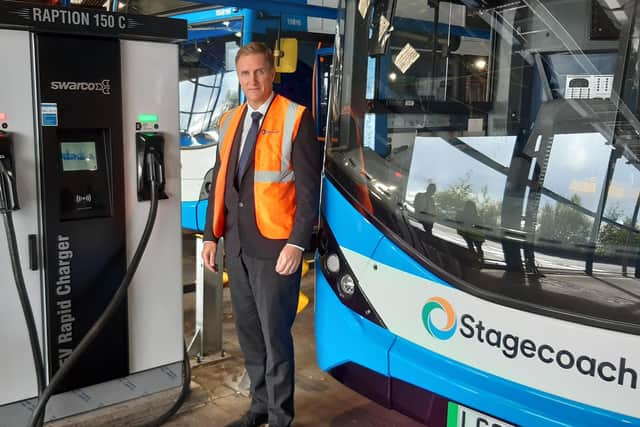Inside Britain's biggest electric bus depot in Glasgow at forefront of public transport revolution
They are surging ahead of the rest of the UK, and even cars on Scotland’s roads – one in six buses north of the Border are now electric or hydrogen powered.
In a green revolution transforming what is by far the most-used form of public transport, around 16 per cent of buses are zero emission compared to 3 per cent in England, the Confederation of Passenger Transport (CPT) industry body has told The Scotsman.
Advertisement
Hide AdAdvertisement
Hide AdThat’s more than 600 of Scotland’s 3,700 buses, although a previous Scottish Government pledge to have half of them electric by the end of this year has been quietly dropped.


Electrification of the fleet is also far ahead of cars, with only some 5 per cent of those in Scotland yet electric, according to the Scottish Motor Trade Association, and they still account for fewer than one in five new car sales.
However, electric buses have some way to go to match ScotRail, 75 per cent of whose passengers now travel on electric trains, the first of which in Scotland started operating in Glasgow more than 60 years ago. The proportion increased from 58 per cent before the electrification of lines such as the main Glasgow-Edinburgh route.
CPT Scotland director Paul White told The Scotsman: “Scotland’s bus and coach sectors, working with Scottish Government, have pushed the pace of decarbonisation, resulting in bus being the mode that is transitioning to zero emission the quickest across the UK.”
The move is seen as helping to attract younger people to buses. Stagecoach, Scotland’s biggest bus operator, said the age group would actively look for electric services, while older people were less interested in the type of vehicle. Under 22s, who have enjoyed free free bus travel since last year, now comprise one quarter of all passengers.


Electric buses are also quieter, can accelerate faster and offer a smoother ride than their diesel predecessors.
Leading the way is Scottish-based First Bus, which boasts the UK’s biggest electric bus depot at its Caledonia complex on the south side of Glasgow. Its sloping “ski jump” charging area, which was completed last year and is visible from the adjacent M74 motorway, has enough charging sockets for the depot’s 150 electric buses.
First has a further 50 electric buses at its Scotstoun depot in the west of the city, and 24 in Aberdeen, making a total of 224, or 35-40 per cent of its Scottish fleet. It also runs 15 hydrogen double deckers in Aberdeen, which succeeded a single-decker fleet in the city that was the first in Europe.
Advertisement
Hide AdAdvertisement
Hide AdThe operator plans to make half its Glasgow fleet electric by next year in the latest stage of phasing out its last diesel bus in Scotland by 2035. One of its latest services to switch from diesel to electric was the ScotRail shuttle between Queen Street and Central stations and Buchanan bus station in Glasgow, three weeks ago.


First Bus Scotland managing director Duncan Cameron said of the changes: “I’m sure it will encourage even more people to leave cars behind in favour of environmentally-conscious bus travel that will help to reduce congestion and improve air quality.”
Meanwhile Stagecoach is rapidly increasing its electric bus numbers, increasing the total from around 30 to 142 over the last year among its 1,208-strong fleet north of the Border. The company is progressively transforming its local networks into all-electric operations, including with 25 buses in Inverness.
Chief operating officer Sam Greer told The Scotsman: “I would expect the pace to pick up. There have been four rounds of Scottish Government funding to kick start decarbonisation, while electric vehicles will become cheaper and have greater parity with diesel.”
The grants, which have totalled more than £170 million so far, contribute some 60 per cent of the purchase price of the buses, which cost up to nearly double that of diesel equivalents.


At Stagecoach’s Dunfermline depot in Fife, its largest in the east of Scotland, the first of its seven chargers were installed at the turn of the year, with 13 of its 97 buses now electric.
Both First and Stagecoach are exploring ways of enabling taxis and other commercial vehicles to use the depot chargers during the day as buses are charged overnight, which take around four hours. Electric buses can operate for 12-15 hours between charges with a range of 150-190 miles, although that is reduced in cold weather.
However, Stagecoach said it would still replacing some of its oldest buses with new diesel vehicles as an interim step ahead of complete decarbonisation by 2035, with 75 due to be delivered over the next ten months. This is for longer rural routes where using electric buses isn’t yet feasible without extra chargers.
Advertisement
Hide AdAdvertisement
Hide AdIn addition, more than 40 per cent of its Scottish fleet does not have the cleanest engine standards so would not be compliant with the low emission zone in Glasgow and those being introduced in Edinburgh, Aberdeen and Dundee next summer.
Industry body CPT warned of difficulties ahead despite the progress made. Mr White said: “While it’s right to recognise the hard work and investment to this point, the challenges to further progress can’t be ignored.
"The cost and delays associated with installing charging infrastructure, the availability of zero emission solutions for longer-distance bus and coach services, and the challenges of making a sustainable business case for decarbonisation for smaller, rural operators are all obstacles still to overcome.”
Transport Minister Fiona Hyslop said: “The bus is currently one of the most climate-friendly transport choices the public can make, and the Scottish Government is committed to decarbonising the full fleet as we encourage more people to leave their cars at home and choose more sustainable ways to travel.”
Comments
Want to join the conversation? Please or to comment on this article.